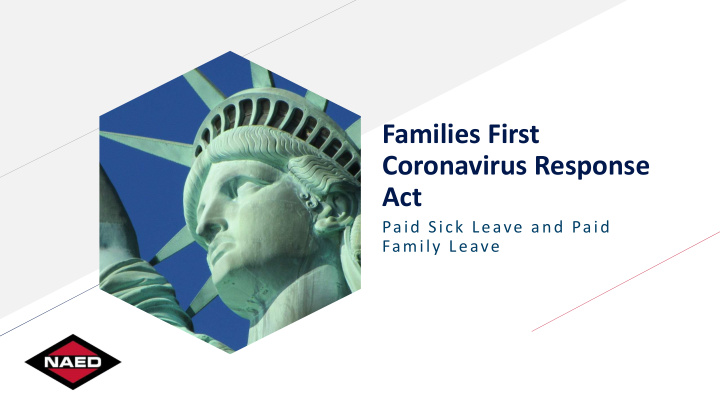



Families First Coronavirus Response Act Paid Sick Leave and Paid Family Leave
Bill requirement • Paid sick leave • 80 hours for full time workers • Average of two week work for hourly workers • Full pay up to $511 per day for workers who are sick with COVID-19 • Up to $200 per day for workers caring for children or other family or forced quarantine • Paid family leave • Up to 12 weeks paid leave (10 paid, two week using paid sick leave) • Includes quarantine and caring for children
Refundable payroll tax credits • Employers will be reimbursed via refundable tax credits for the cost of wages and employer contribution for health care insurance during the either sick or family leave. • Employers will deduct the cost of paid sick or family leave from the employer portion of Social Security taxes. • Employers will submit emergency paid sick or family leave expenses as part of their estimated quarterly tax payments. • $5,110 for sick leave max • $2,000 for care leave • For employees taking family leave, the deduction is capped at $200 per day up to $10,000 per year. • The family medical leave deduction is also refundable if the total deduction exceeds the tax liability.
Small Business and Individual Provisions of CARES Act
SBA Loan changes • Provides guaranteed loans for financial assistance through the Small Business Administration • Authorizes $349 billion for the Payment Protection Program, also known as 7(a) loans • Must be under 500 employees to qualify • Maximum of $10 million based on formula tied to payroll costs • Must be used for payroll support, mortgage/rent payments, or utility payments • Maximum interest rate of 4% • Allows for loan forgiveness for loans taken out prior to February 15, 2020 • Applies up to 8 weeks of loans taken out for payroll, interest payments, or mortgage payments • SBA buys the loan from the lender
Employee retention tax credit • New refundable payroll tax credit for 50 percent of wages paid by employers to employees during the COVID-19 crisis. • The credit is available to employers whose • (1) operations were fully or partially suspended, due to a COVID-19- related shut-down order, or • (2) gross receipts declined by more than 50 percent when compared to the same quarter in the prior year.
Delay of payment for employer payroll taxes • Allows employers and self-employed individuals to defer payment of the employer share of the Social Security tax they otherwise are responsible for paying to the federal government with respect to their employees. • Requires that the deferred employment tax be paid over the following two years, with half of the amount required to be paid by December 31, 2021 and the other half by December 31, 2022.
Changes to Net Operating Loss rules (NOLs) • Any NOL from 2018, 2019, or 2020 can be carried back five years. • Temporary suspension of income limitation • These changes will allow companies to utilize losses and amend prior year returns, which will provide critical cash flow and liquidity during the COVID-19 emergency. • Pass-through businesses and sole proprietors can also utilize NOL carryback to access cash flow • Previous rules were changes by TCJA
Changes to business interest deduction • Businesses can deduct business interest up to 50% of taxable income for 2019 and 2020
Technical correction to allow Qualified Improvement Property • NAED priority • Allows businesses to fully expense improvements to existing buildings included upgrades to electrical system, lighting, and equipment
Individual provision of note
Creation of the Pandemic Unemployment Assistance program • Expands unemployment to provide payment to those not traditionally eligible for unemployment benefits (self-employed, independent contractors, those with limited work history, and others) who are unable to work as a direct result of the coronavirus public health emergency.
Additional unemployment changes • Increases unemployment compensation benefits by $600 per week • This is being redrafted today to prevent it becoming better to lay off workers than keep them employed if the unemployment benefit is larger than their typical paycheck • Removes the one week waiting period for unemployment benefits • Lengthens total unemployment eligibility by 13 week • Expands “Short-time” compensation payments • Allows companies to reduce hours without laying off workers with additional income provided by state governments (funded by federal payments)
2020 recovery rebates a.k.a. stimulus checks • All U.S. residents with adjusted gross income up to $75,000 ($150,000 married), who are not a dependent of another taxpayer and have a work eligible social security number, are eligible for the full $1,200 ($2,400 married) rebate. In addition, they are eligible for an additional $500 per child. • The rebate amount is reduced by $5 for each $100 that a taxpayer’s income exceeds the phase-out threshold. The amount is completely phased-out for single filers with incomes exceeding $99,000, $146,500 for head of household filers with one child, and $198,000 for joint filers with no children.
Misc. • Allowed use of qualified retirement funds • Waives the 10% early withdrawal penalty for up to $100,000 in early distributions • Three years to pay back before being taxed, if not returned to the retirement fund it is taxed over three years. • Only allowed to families with a COVID-19 patient or who experience adverse financial consequences as result of COVID-19 such as lay-offs, reduced hours, or taking care of children because of school closures • Suspension of Required Minimum Distributions for individual retirement accounts • Suspended through end of 2020
Recommend
More recommend